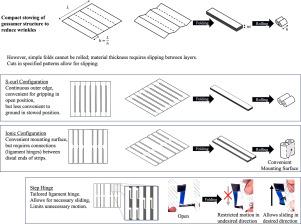花丝结构的折纸折叠图案开发
IF 7.1
1区 工程技术
Q1 ENGINEERING, MECHANICAL
International Journal of Mechanical Sciences
Pub Date : 2024-10-16
DOI:10.1016/j.ijmecsci.2024.109780
引用次数: 0
摘要
用于卫星的绞索结构是一种大型、薄型的可部署结构,对空间应用很有吸引力,因为这种结构可以紧凑地装载运输,部署后具有较大的功能表面积。特别是反射阵列天线,由于可以在薄膜上实现,因此是索纱结构的候选者。然而,反射阵列天线的效率会随着平面偏差(包括塑性变形褶皱引起的偏差)而降低。卷膜可以防止一些塑性变形,但需要在卷在一起的各层之间进行相对滑动。在这项工作中,我们描述、分析并演示了两种可部署格萨姆结构的卷曲配置,其基础是卷曲和折叠膜以及允许层间滑动的替代褶皱的组合。切口和阶梯铰链被用作替代褶皱。阶梯铰链将薄膜连接起来,同时限制了单一方向的滑动运动,减少了结构中的褶皱。折叠、滚动和滑动连接的组合可减少塑性变形,同时提供高效的收纳包装。本文章由计算机程序翻译,如有差异,请以英文原文为准。

Origami folding pattern development for gossamer structures
Gossamer structures for satellites are large, thin deployable structures that are attractive for space applications because they can be stowed compactly for transportation and deployed to have large functional surface areas. Reflectarray antennas, in particular, are candidates for gossamer structures because they can be realized on thin membranes. However, the efficiency of reflectarray antennas decreases with any deviations from a flat plane, including those induced by plastically deformed creases. Rolling membranes can prevent some plastic deformation, but requires relative slipping between layers that are rolled together. In this work, we describe, analyze, and demonstrate two rolled configurations for deployable gossamer structures based on a combination of rolled and folded membranes and surrogate folds that allow for sliding between layers. Cuts and Step Hinges are used as surrogate folds. Step Hinges connect membranes while limiting slipping motion in a single direction and reducing wrinkling in the structure. The combination of folding, rolling, and sliding connections reduces plastic deformation while providing a highly efficient packing of the stowed form.
求助全文
通过发布文献求助,成功后即可免费获取论文全文。
去求助
来源期刊

International Journal of Mechanical Sciences
工程技术-工程:机械
CiteScore
12.80
自引率
17.80%
发文量
769
审稿时长
19 days
期刊介绍:
The International Journal of Mechanical Sciences (IJMS) serves as a global platform for the publication and dissemination of original research that contributes to a deeper scientific understanding of the fundamental disciplines within mechanical, civil, and material engineering.
The primary focus of IJMS is to showcase innovative and ground-breaking work that utilizes analytical and computational modeling techniques, such as Finite Element Method (FEM), Boundary Element Method (BEM), and mesh-free methods, among others. These modeling methods are applied to diverse fields including rigid-body mechanics (e.g., dynamics, vibration, stability), structural mechanics, metal forming, advanced materials (e.g., metals, composites, cellular, smart) behavior and applications, impact mechanics, strain localization, and other nonlinear effects (e.g., large deflections, plasticity, fracture).
Additionally, IJMS covers the realms of fluid mechanics (both external and internal flows), tribology, thermodynamics, and materials processing. These subjects collectively form the core of the journal's content.
In summary, IJMS provides a prestigious platform for researchers to present their original contributions, shedding light on analytical and computational modeling methods in various areas of mechanical engineering, as well as exploring the behavior and application of advanced materials, fluid mechanics, thermodynamics, and materials processing.
 求助内容:
求助内容: 应助结果提醒方式:
应助结果提醒方式:


